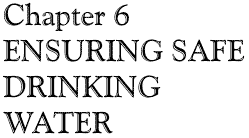
| ch. 6, pp. 67 - 69 |
Some customers are very wary of drinking water that once was contaminated with TCE, eve if it now meets drinking water standards. Several options exist for using the treated water as part of the city’s drinking water supplies, subject to approval by the EPA and other parties to the consent agreement, and subject to interpretation of the Water Consumer Protection Act. These include releasing it into the Santa Cruz River; using it to create artificial wetlands; or injecting it underground with injection wells. Others argue that after the expense of purifying the water, it is wasteful to pollute it again by discharging it into the river. They argue that since the city does not have to pay to treat the water it is essentially free water. Also, they argue that the treated water is actually the cleanest water in the city system and the most frequently tested. Pollution From Landfills Another identified source of groundwater pollution is old landfills built before current regulations about landfill construction were in place. Some historic wildcat landfills pose problems in determining what actually was dumped there. Officials are concerned about such wastes as pesticides, dry cleaning solvents, paints or discarded car batteries containing lead. Also, decaying organic material can release methane. Officials are most concerned about landfills located near riverbeds where flood waters can leach materials out of the landfills into the water table. Recharge projects must not be located in such areas. One significant landfill pollution site is on Tucson’s east side, along the Pantano Wash between Broadway and Speedway Boulevard. This is the location of a 130-acre landfill that the city and county used from 1959 to 1974. Concern exists that landfill gases may be moving either in solution or by diffusion and pressure gradients toward the water table. A plume of contaminated water is moving westward at about one and half feet per day. This rate increases when the demand for water is high because, as the nearby five wells pump water, the contamination plume moves forward. These five wells, however, are only used as a last resort when summer demand is high. The water from these wells meets water quality standards. The concern in this area is that the plume which contains PCE will migrate towards a cone of depression in an area where Tucson Water has active wells. If recharge were to occur along or near the Pantano Wash in that area, the active wellfield could become contaminated . Other Pollution A large area beneath the downtown area is contaminated with petroleum products from a variety of sources, probably largely from activities connected with the railroad. Some other areas also have petroleum contamination, mostly from old leaking underground storage tanks, which the state now regulates. Water is not pumped from these polluted sources. Treatment Plants Most of the sewage generated in the metropolitan area is transported by gravity through pipes to two large Pima County wastewater treatment plants, located along the lower Santa Cruz River at Roger and Ina roads. Solids are removed and, through a bacteriological process, disease-causing microorganisms are reduced. After the treatment process is complete, the wastewater is disinfected, with most of it released to the Santa Cruz River. EPA maintains strict standards for the quality of the water released, and the water is frequently tested. The treatment process is not designed to handle toxic materials; in fact, some toxics can make the treatment process less effective by killing helpful bacteria. Pima County has a pretreatment program for businesses that produce toxic wastes. The program requires such businesses to treat or reuse hazardous substances, rather than releasing them into the sewers. Many people, however, are unaware of the problems that materials such as oil and paint re mover can create and flush them down the drain. Pima County attempts to educate individuals about proper disposal of hazardous materials and has a program to collect household hazardous materials.
Some of the wastewater from the Roger Road Treatment Plant receives tertiary treatment in a City of Tucson facility and distributed for use on golf courses and other turf facilities. Tertiary treatment involves treatment through sand filters or soil and additional disinfection. Part of the effluent is taken to Sweetwater Wetlands, an artificial wetland Tucson Water completed in 1998. This wetland adds another layer of treatment before discharging the water to recharge basins. Artificial wetlands have become increasingly popular in Arizona in recent years as they serve not only to treat the water, but also provide wildlife habitat and recreation. A small amount of wastewater is taken from the Ina Road plant for agricultural use and to irrigate the county’s Arthur Pack Golf Course. Some areas, such as Green Valley, are located far from major treatment plants and have their own small facilities, almost all of which are operated by Pima County. Other areas, such as Marana, are downhill from the major treatment plants. Their sewage must either be treated on-site or pumped uphill for treatment. A few areas have privately constructed small treatment plants, with treated water applied to such uses as golf courses. Septic Systems An estimated 10 to 15 percent of homes in the Tucson area have their own septic tanks. Although most septic systems are in rural areas, some neighborhoods within city limits also are served by septic systems. A county permit is required to install the system, and the applicant must show that the soils are appropriate for percolation of water.
|
